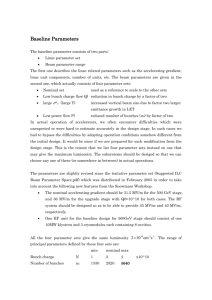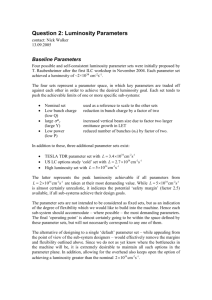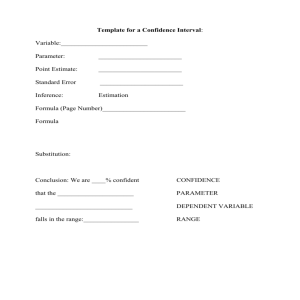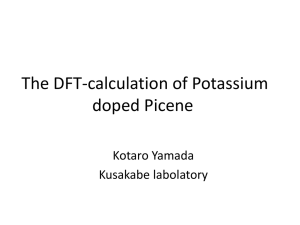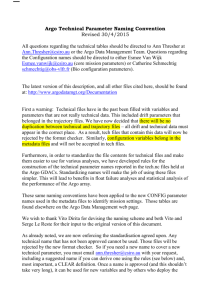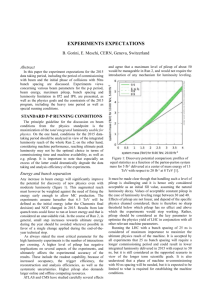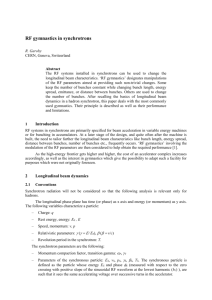Parameter
advertisement
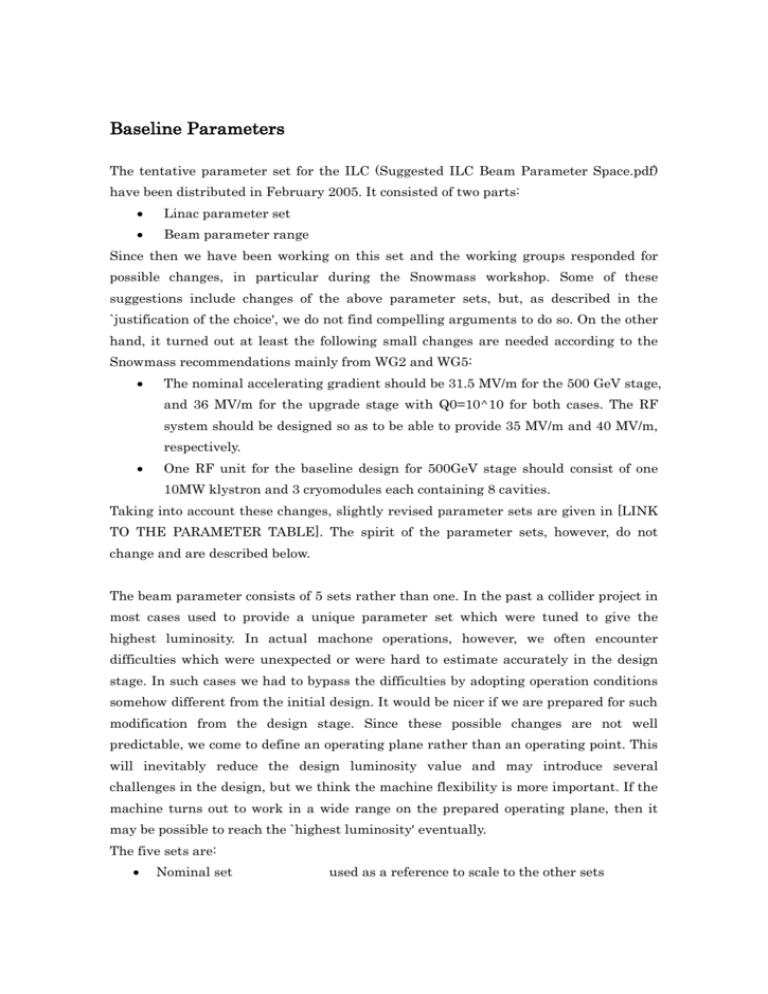
Baseline Parameters The tentative parameter set for the ILC (Suggested ILC Beam Parameter Space.pdf) have been distributed in February 2005. It consisted of two parts: Linac parameter set Beam parameter range Since then we have been working on this set and the working groups responded for possible changes, in particular during the Snowmass workshop. Some of these suggestions include changes of the above parameter sets, but, as described in the `justification of the choice', we do not find compelling arguments to do so. On the other hand, it turned out at least the following small changes are needed according to the Snowmass recommendations mainly from WG2 and WG5: The nominal accelerating gradient should be 31.5 MV/m for the 500 GeV stage, and 36 MV/m for the upgrade stage with Q0=10^10 for both cases. The RF system should be designed so as to be able to provide 35 MV/m and 40 MV/m, respectively. One RF unit for the baseline design for 500GeV stage should consist of one 10MW klystron and 3 cryomodules each containing 8 cavities. Taking into account these changes, slightly revised parameter sets are given in [LINK TO THE PARAMETER TABLE]. The spirit of the parameter sets, however, do not change and are described below. The beam parameter consists of 5 sets rather than one. In the past a collider project in most cases used to provide a unique parameter set which were tuned to give the highest luminosity. In actual machone operations, however, we often encounter difficulties which were unexpected or were hard to estimate accurately in the design stage. In such cases we had to bypass the difficulties by adopting operation conditions somehow different from the initial design. It would be nicer if we are prepared for such modification from the design stage. Since these possible changes are not well predictable, we come to define an operating plane rather than an operating point. This will inevitably reduce the design luminosity value and may introduce several challenges in the design, but we think the machine flexibility is more important. If the machine turns out to work in a wide range on the prepared operating plane, then it may be possible to reach the `highest luminosity' eventually. The five sets are: Nominal set used as a reference to scale to the other sets Low bunch charge (low Q) reduction in bunch charge by a factor of two large *y (large Y) increased vertical beam size due to factor two larger emittance growth in LET Low power (low P) reduced number of bunches (nb) by factor of two High luminosity (high L) smaller IP beam size and shorter bunch. (This is not a part of the `baseline' but is added just for reference.) Among these the first four sets give the same luminosity L 2 10 cm s 34 -2 -1 to be compared with the TESLA TDR peak luminosity L 3.4 10 cm s , while the high L 34 -2 -1 gives L 5 10 cm s . 34 -2 -1 As descibed above the parameter sets are not intended to be considered as fixed sets, but as an indication of the degree of flexibility which we would like to build into the machine. Hence each sub-system should accommodate – where possible – the most demanding parameters. The final ‘operating point’ is almost certainly going to be within the space defined by these parameter sets, but will not necessarily correspond to any one of them. The required range of important parameters are (they are of course related): min nominal max Bunch charge N 1 2 2 Number of bunches nb 1330 2820 5640 Linac bunch interval tb 154 308 461 ns Bunch length z 150 300 500 m Vertical emitance y 0.03 0.04 0.08 mm.mrad IP beta (500GeV) x 10 21 21 mm y 0.2 0.4 0.4 mm x 10 30 30 mm y 0.2 0.3 0.6 mm IP beta (1TeV) x10^10 The alternative of designing to a single ‘default’ parameter set – while appealing from the point of view of the sub-system designers – would effectively remove the margins and flexibility outlined above. Since we do not as yet know where the bottlenecks in the machine will be, it is extremely desirable to maintain all such options in the parameter plane. In addition, allowing for the overhead also keeps open the option of achieving a luminosity greater than the nominal 2 10 cm s 34 Justification of the choice -2 -1 if not as high as High L. A few problems associated with the baseline parameter sets and some possibilities of different parameter sets were pointed out from working groups during the Snowmass workshop. Short bunch Low Q and High L parameter sets demand a bunch length as short as 150 m, to be comparared with 300 m in the nominal set. WG1 concluded that, though a single-stage bunch compressor is just enough for compressing a 6mm bunch from the damping ring to 300 m, a two-stage compressor is mandatory for a shorter bunch length or for a DR bunch longer than 6mm. Obviously a two-stage compressor is more expensive and requires a longer site length. However, we do not know yet exactly the cost and length differences. A shorter two-stage compressor is still in consideration. It is mentioned that a two-stage compressor is still desirable even for the nominal parameter set. Thus, we recommend to retain the possibility of a shorter bunch at this moment. Long Pulse Length in the Main Linac H. Padamsee and B. Foster suggested a longer beam length (accordingly a longer klystron pulse length) in the main linac with the same pulse charge. If, for example, the beam pulse length is doubled (2ms), the beam current and, therefore, the number of modulators/klystrons would be halved, which reduces the cost of the RF system. The cost of the cryogenics system, on the other hand, increases due to the higher duty. It was stated, taking into accout all above, the total cost is expected to decrease. It was also pointed out a longer pulse would ease the demand on the MPS and is also better for the detector performance. However, according to C. Adolphsen, the total cost increases slightly. A more detailed study of the cost is needed. In addition to the cost uncertainty, a longer pulse requires a longer modulator/klystron pulse which is not currently available. Thus, we rank this possibility as an `alternative' solution. Larger Number of Bunches The Low Q parameter set demands a number of bunches as large as about 6000. This is particularly demanding for the design of the Damping Ring. As far as the kicker rise time is concerned, the 17km dogbone ring can accept 6000 bunches and the 6km ring is marginal and may require two rings. Though the beam current in the Damping Ring is the same as that for the nominal set, the effect of the electron cloud still has uncertainty. We would like to wait for the conclusion from the Damping Ring mini-workshop at CERN. Very Low Q Parameter Set J. Gao proposed a `Ver Low Q' parameter set in which the bunch charge is 0.6×1010 (40% lower than the nominal). This demands more bunches (6000), a shorter bunch (120 m), a higher repetition rate (8 Hz) together with a tight focusing at the IP. The main motivation is to reduce the space-charge effect in the Damping Ring (no need of the coupling bump) and a smaller disruption (Dy=9). With this parameter set the smaller IP spot size (horizontally and vertically) and the shorter bunch is very much demanding. It is necessary to evaluate if these demands balance the relaxed effects of the space-charge and the disruption. Smaller Number of Bunches with Higher Rep Rate S. Guiducci suggested reducing the number of bunches by 2 (as in the low P set), but maintaining the 1ms pulse. Luminosity is recovered by increasing the repetition rate to 10 Hz, requiring a factor of two in the damping time (possible with a factor two shorter ring, assuming the same kicker rise time). The resulting factor two drop in linac beam current reduces the peak beam power by a factor of 2 and could potentially save half the 10MW klystrons; but the fill time also increases, thus reducing the efficiency and increases the dynamic cryoload by a factor of two. Increasing the vertical emittance by a factor of two, while reducing the horizontal emittance by the same factor was also discussed (Guiducci); this option increases the beamstrahlung by a factor of four, however, assuming that no modifications to the demagnification in the final focus are made. High L A. Seryi pointed out a difficulty in designing the IR region for the High L set especially at 1TeV. The disrupted beam has a long low-energy tail due to the strong beamstrahlung. The lowest energy that the dumpline can accept is about 0.3E 0. The integrated power below this energy which the detector system can tolerate is less than 10 W. With the present 1TeV High L set, 10 W is reached already at 0.13 E0. To solve this problem, the beamstrahlung (especially the Upsilon parameter) has to be reduced. He suggested a longer bunch (300 m), larger x and y , a lower vertical emittance 0.023 mm.mrad and an increased bunch charge ( 2.4 10 ). This set causes a tighter 10 vertical tolerances (smaller DR emittance and a smaller budget of emittance increase) and a larger disruption (kink instability). The requirements can be a little relaxed by choosing the nominal bunch charge but with a slightly decreased luminosity from the High L set. The required change is within a reasonable range from the standard set and may be feasible by the time when we reach 1TeV. We do not list this option in the standard parameter sets since the High L set itself is not the baseline. Required R&D for the Baseline The performace of the proposed two-stage bunch compressor need to be confirmed including errors. It is also desirable to see if a shorter two-stage compressor is feasible or not. The Damping Ring Design with 6000 bunches need to be established. Required R&D for the Alternative Parameters Long Pulse with 5 Hz or 10 Hz Technical feasibility of a long-pulse RF system need to be investigated in addition to its detailed cost estimation.
